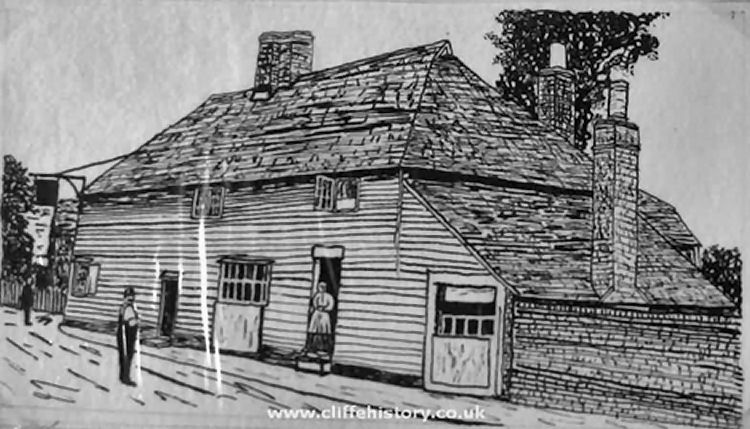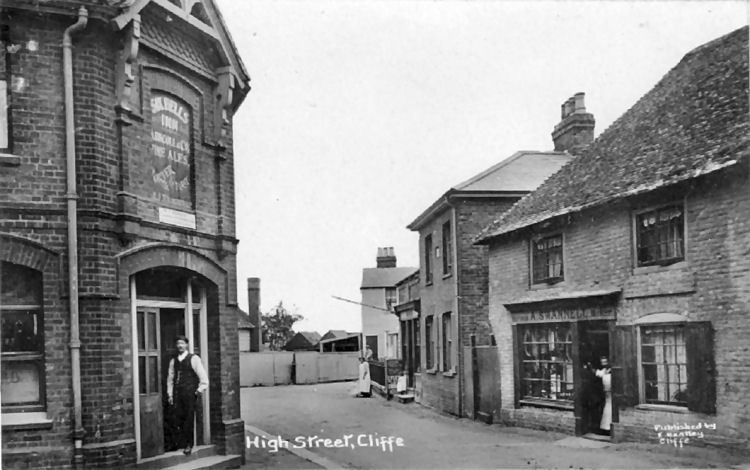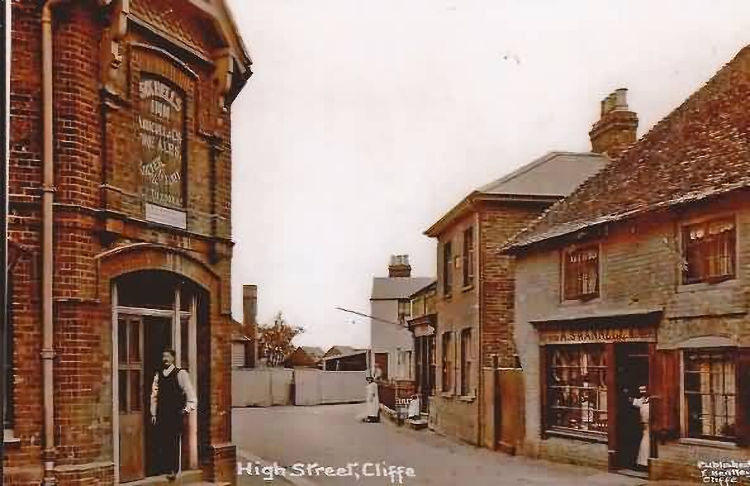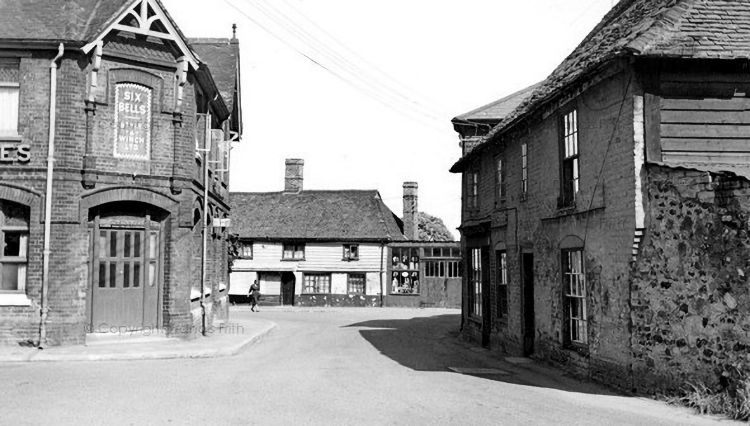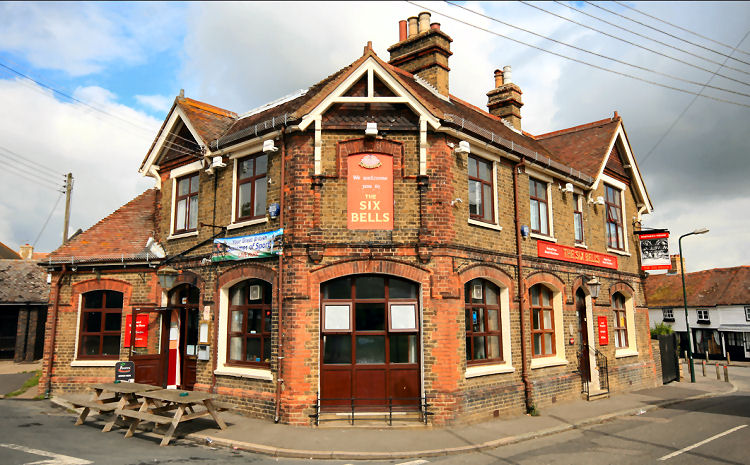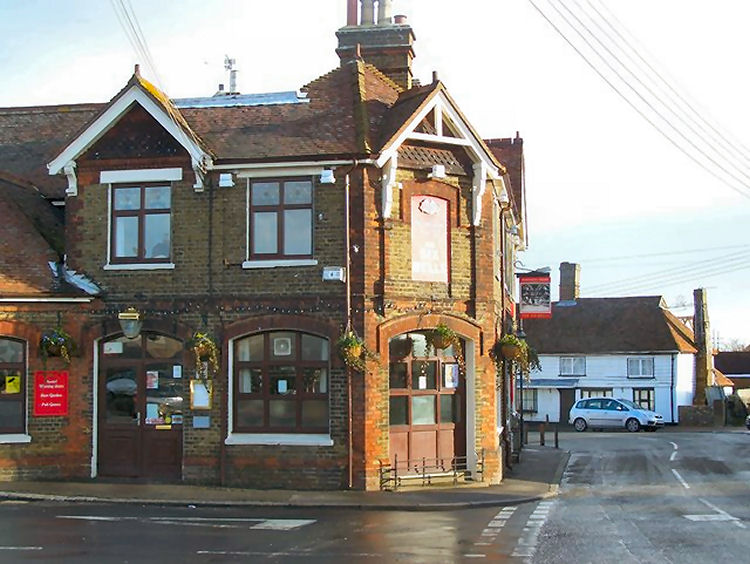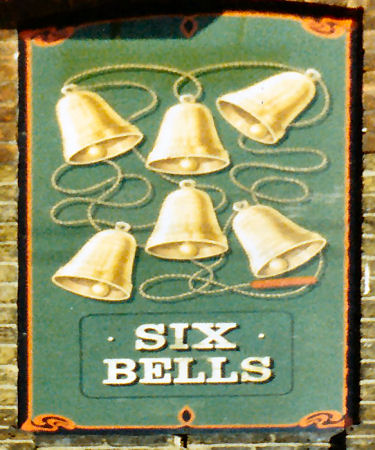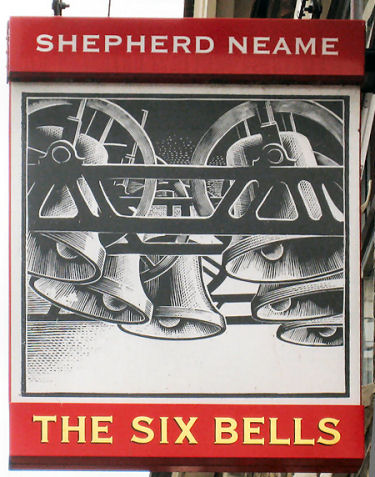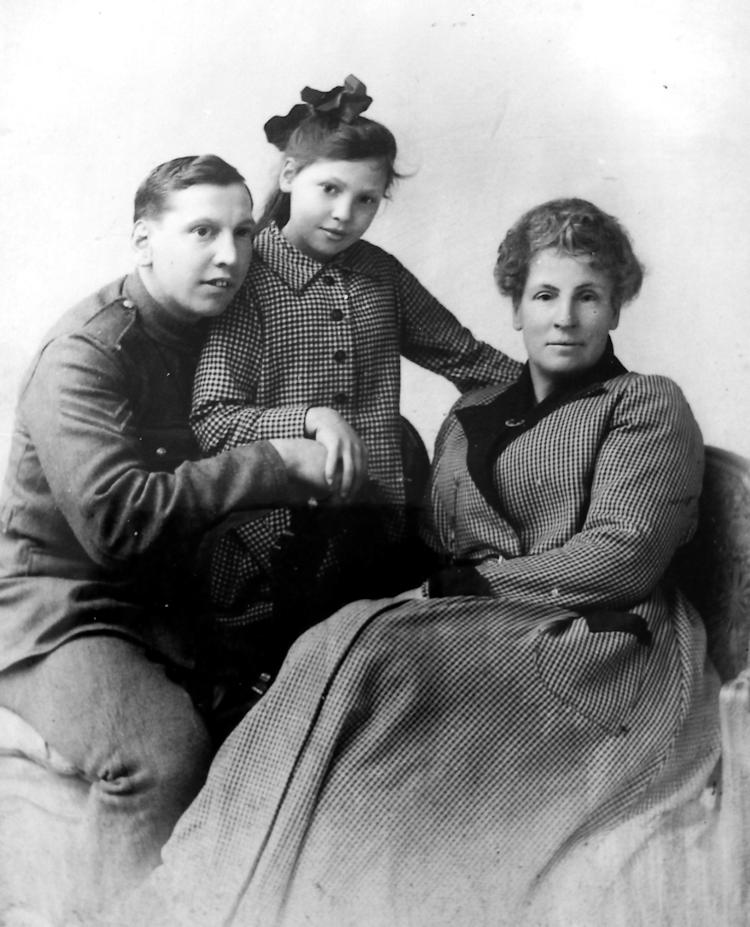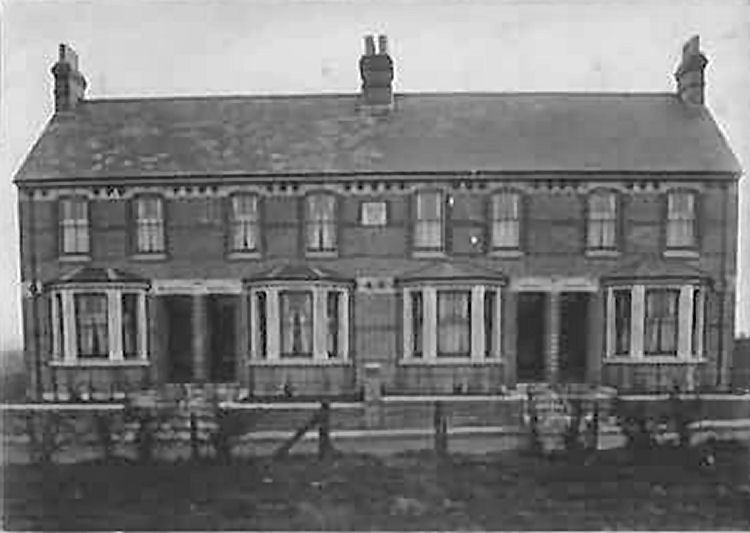|
The following information has been taken from
http://www.cliffehistory.co.uk/pubs.html (The Bull:
renamed c. 1720-1738)
Early 6 Bells
Together with the "Black Bull,"
the "Six Bells" public house is one of the oldest beer-houses in Cliffe.
The name derives from the six bells that were once contained in the
tower of the close-by parish church of St. Helen's. Today the church of
St. Helen's has a total of eight bells: two more bells were added in
1864.
In 1902 the "Six Bells" was home to Cliffe Football Club whose
ground was situated at Six Bells Meadow: they played in a blue strip and
whose Secretary was a Mr. Archilbald Creighton.
The "Six Bells" is now
the oldest remaining public house in the village of Cliffe with the
closure of all the 'marsh' pubs, the "Staff of Life," the "Three Merry
Boys," the "Compasses" and the recent demise of the "Black Bull" and
"Victoria Inn" in the village.
One of the more interesting characters
who was associated with the Six Bells was a Mr. William John Thorndike
who was licensee between 1901 & 1912. We are indebted to Mr. John
Gilbert for his meticulous research into the 'Thorndike' family and his
agreement for us publish the story of one of his ancestors.
The life and family of William John Thorndike
1863-1912
William John Thorndike the son of William Thorndike and Emma Mayhew was
born on the 3rd of September 1863 at Johnsons Whiting Works cottages
which were in later years known as Flint Cottages or Granny Callars and
which laid to the northern end of Cliffe Canal alongside the "Canal
Tavern," which under the stewardship of one Isaac Thompson was known
locally as the Shant.
He was of course not to know that in later years he would become
landlord of that same public house whose smells and banter surrounded
his crib.
In 1871 William John aged 7 and studying at the village C of E school is
living at the same cottage on Cliffe Creek with his father William who
aged 32 is as might be expected a cement labourer, mother Emma aged 40
and siblings Joseph aged 5 George 3 and Sarah Just 1. Also present is a
20 year old cement labourer and lodger named Alfred Osborn. In 1881 and
aged 17 William John is still living with his father William who was
born in Occold, Suffolk and his mother Emma.
William John is like his father and brothers Joseph Edward and George
Thomas labouring in the cement works that surround his home.
Also present at this time are further siblings Sarah Ann aged 7, Maria 4
and Fanny just 1. Present also within the home is a boarder; one George
Filmer who aged 24 was born at Cliffe.
In 1885 William John decides to travel abroad, in what is most likely a
bid to escape the daily toil within the cement works, earn enough for a
different life upon return and perhaps win the hand of his childhood
sweetheart Priscilla Albon.
He leaves from Southampton on the Steam Ship Liguria which is on charter
to the Orient Line in January 1882 on a route that takes him to
Gibraltar, Port Said, Suez, and Colombo before reaching his destination
in Australia. It is known for reasons that will be explained later that
William John ended up at Murray Downs, Swan Hill, in Victoria Australia.
Here he most likely worked on one of the many sheep stations that were
spread across the area.
Correspondence with Doctor Rob Pilgrim who is the senior curator of the
Pioneer Settlement archives at Swan Hill, Victoria has uncovered no
record of the activities of William John during the period that he was
there. It is most likely then that he worked hard and kept himself
within the law.
Even today there is evidence of a substantial Aborigine community at
Swan Hill though Murray Downs is now a tourist trap that boasts a up
market Golf Course and many hotels.
In May 1889 William John joins the Steam Ship Orient for his return trip
to England. Soon after his return to the UK William John Thorndike aged
26 marries Clara Hammond, 27, on the 18th of August 1890 at the church
of St Nicholas, Strood. A year later the couple are found to be living
at Upper Stoke, a village that is located upon the Hoo peninsular
between High Halstow and the Isle of Grain. We can only assume that the
reputation of the Thorndike family who for many years had held the
licence of the "Victory" Beer House (later the "Victoria Inn") and his hard
earned new financial situation impressed a brewery to the extent that he
is at this time a Licensed Victualler and landlord of the "White Horse" in
that same village.
On the 31st of July this year a son who is named William Hector is born
to the couple and baptised at St Helen's church, Cliffe on the 30th of
August.
When a vacancy for a Landlord in Cliffe arises he takes it and in 1893
when their second child, Winifred May, is baptised at St Helen's he is
the Licensed Victualler running the "Canal Tavern" [Shant] that is located
just a few yards from the cottage where he was born. He is still the
landlord of the "Shant" in 1896 when Gladys Marion, the couple's third
child, is baptised at St Helen's, Cliffe on the 29th of March of that
year.
Sadly on the 29th of December, just l year and 10 months after her birth
at Cliffe Creek, on the 20th of February 1896 she is to die of
Meningitis.
Another daughter is born on the 6th of April 1899 and baptised as
Dorothy at St Helen's Church on May 14th of that year.
Sometime about 1894 [assuming that he was aged about 20] Alfred Charles
Gilbert travels from his birthplace on the Isle of Wight to Cliffe in
search of work. Having little money he is given permission by William
John to sleep in one of the outbuildings attached to the "Shant."
It was here that he first met Fanny, William John's youngest sister,
who will eventually become his wife.
In 1901 William John Thorndike, aged 37, is the landlord of the "Six
Bells Inn," High Street, Cliffe where he shares his life with wife Clara
also 37, Mary Ann Clifford, 23 who is his niece and his sister Francis
[Fanny] aged 21 who are both in his employ as barmaids/domestic servants
and also his son William Hector, aged 9, and daughters Winifred May and
Dorothy aged 7 and 1.
Another Cliffe girl by the name of Emmaline Petts, aged 15, is also
residing and employed by William John and Clara as a domestic servant.
Maud Sophia Wallis, 15, and born in Greenwich who is visiting and George
Batchelor, an agricultural labourer aged 61, from Newport on the Isle of
Wight who is most likely boarding at the inn complete the household mix.
On Sunday the 7th of July in this year of 1891, which was probably only
a few weeks after the census was taken; a terrible tragedy occurs within
100 yards of the "Six Bells." This tragic affair may have affected William
John for the rest of his life and possibly contributed to his premature
death.
Two cottages that lay opposite the chapel [which was later the
Temperance Club] and adjoined the forge were destroyed by fire.
The Topley family appear to have escaped before their home collapsed but
tragically the Kenknight family, who lived next door, were trapped by
the flames. Ellen Elizabeth, aged 7, Lillian May, 4, and their father
Richard Henry Kenknight were found in each other's arms burnt to death.
Their mother Elizabeth Jane died two days later in hospital. Their
burial takes place on the 15th of that month at St Helen's Church,
Cliffe. It is believed that William John Thorndike was among the would
be rescuers and sustained a head injury when the upper floor collapsed
upon him.
Sadly Clara, the wife of William John, dies in January 1907 and is
buried at St Helen's, Cliffe on the 31st of that month. A further
tragedy hits William John when his son William Hector dies of TB, aged
just 17, he is also buried at St Helen's, Cliffe on the 17th of August
1908.
Whether William John has a longing for a return to his Australian life
of adventure it is not known but what is known however that he has four
houses built on Buttway Lane with a view over the Thames and names them
Murray Downs, Swan Hill, Victoria and Australia Which replicated his
place of settlement in that land.
Cliffe cottages
The 1911 census finds William John, a widower aged 47, still landlord of
the "Six Bells" public house in Cliffe and living with his widowed mother
Emma Thorndike [Mayhew] aged 68. Ida Caroline Smith, a Cliffe girl of
19, is employed as a servant within the pub as is Ezerich Farrow, a
widow aged 69, who was born in Suffolk.
Having seen William John's willingness to take in family waifs and
strays it is most likely that Ms Farrow is a relative of his Suffolk
born Father.
Winifred May Thorndike, his daughter, is also present aged 17 and though
no occupation is given she probably assists within the public house.
On the 16th of May 1912 William John marries his child hood sweetheart
Priscilla Albon/Payne at Chatham Registry Office. His home is noted as
"Six Bells," Cliffe at Hoo and his father is named as William Thorndike
[deceased] Priscilla's home is the "Fountain" Public House, High Street,
Chatham and her father Isaac Albon. The ceremony was witnessed by one
Henry Tomlin and Edwin Albon: Priscilla's brother.
When the inquest regarding the death of William John is studied it will
show that this was something of clandestine ceremony. The details of
which were withheld from his friends and with the known exception of
Thomas his cousin who was landlord of the "Victoria Inn."
On the 22nd of May 1912 William John Thorndike aged 48 takes his own
life within the back room of the "Six Bells" Public House, High Street, Cliffe.
Details of this tragic event and of the state of mind of William John
can be read in all its very sad detail on the Death certificate and the
newspaper reports of the time.
William John Thorndike is buried on the 28th of May at St Helen's Church
Cliffe where his headstone [which has escaped a monumental cull carried
out by the incumbent Vicar] still stands. It should be noted also that
although he committed suicide William John Thorndike was allowed a
burial within the church grounds which was not always the case. This
perhaps conveys as much as any epitaph can, the stature of the man and
reflects perhaps upon the fact that the scars that he carried both
physically and mentally after the tragic fire, that took the Kenknight
family in 1901, were considered when the decision to allow the burial
was made.
It seems that Priscilla Thorndike a widow after only 6 days of marriage
continues to live within and run the "Six Bells" for some years after the
death of her husband William John. She must have been a very strong
woman to have done so bearing in mind that her husband had killed
himself and in his state of mental unbalance at the time of his death
had indicated that he considered the marriage to Priscilla a betrayal of
his first wife Clara.
Under those circumstances she would have needed the continued presence
and clear support of Emma, William John's mother within the business to
have retained the custom of his friends and associates.
Emma is to outlive her son by 14 years dying at the age of 85 in 1926.
Isaac Albon, the father of Priscilla, comes to live at the "Six Bells"
after William John's death, for his death is added to her husband's
memorial stone in 1919 having died on November 14th of that year.
Between times Winifred May, aged 21, the daughter of William John and
Clara marries George Earnest Smith, 23, a Joiner by trade on the 4th of
July 1914. George Earnest Smith's address being given as Murray Downs
[Kangaroo Villas] which was most likely still owned by the Thorndike
Family at the time.
The father of George was Samuel James Smith a foreman Joiner who was
probably living with his son at the time of his marriage.
The influx of carpenters to Cliffe was probably being drawn to Curtis
and Harvey who were employing such men at this time. Alfred Charles
Gilbert, who had married Fanny Thorndike in 1907, being one of them,
Dorothy, 21, the youngest daughter of William John Thorndike and Clara
Hammond also marries a Carpenter by the name of Walter Harold Edward
Crockett, aged 24, on the 10th of September 1920 at St Helen's Church
Cliffe.
|
